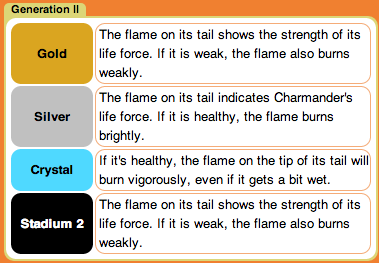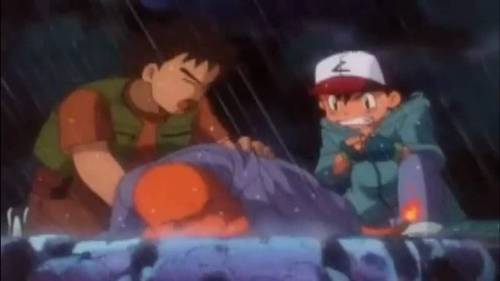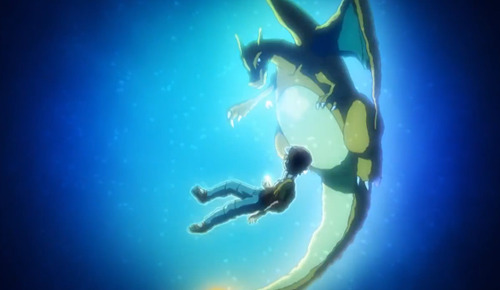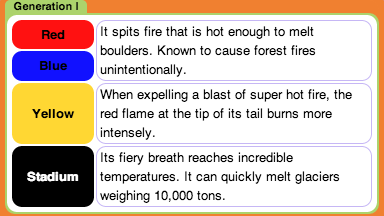-Asked by fullgrizzly94 for my Pokemon Science prompt-
Ah, yes. The infamous question of Charizard’s tail flame. For those of you unaware, the common fact that everyone now knows as a solid piece of Pokemon mythos was actually first uttered by everyone’s favorite blind man, Brock, in the anime episode ‘Charmander – The Stray Pokémon’. The Gym Leader does not leave anything up for debate when he first points out that a stray Charmander’s tail flame is weak, indicating the Pokemon is unhealthy, and he later goes as far as to bluntly announce “If that flame on its tail goes out, it will die!”
[Brock’s serious, and he ain’t goin’ back to jail!]
Now, this had not been stated anywhere else in the franchise yet, as the manga had been absent of mentioning any such thing, and the Pokedex entries in the games, while talking about the tail a lot, never related it to Charmander’s health.
But the anime was so popular at this time in its run that it basically reserved the right to override game canon from time to time and expand on various unexplored mythos. This was not the first time it happened either, but that’s another story for another day. Brock’s statement about Charmander’s tail would later be integrated into the games proper.
But wait! Take a look at those entries! It doesn’t say anything about the flame sustaining Charmander’s life. It just mentions Charmander’s flame as an indicator of its life!
…Oh… well, that’s odd… But Brock said… !!
Wait a minute! When Brock first noticed the Charmander, he diagnosed it as unhealthy by looking at its flame! And then later all he said was “If the flame on its tail goes out, it’ll die!”
Perhaps the fanbase has misinterpreted Brock’s quote to a degree. It sounds to me that, when taking it in context, all Brock is saying here is 1.) the flame on a Charmander’s tail indicates its health. 2.) The flame on the tail of the Charmander he, Ash, and Misty found was already weak. 3.) If the flame goes out completely (representing Charmander’s health depleting completely), it will die.
I mean, sure, Ash and the gang rushed out to save that Charmander in the rain…But that may have had more to do with the fact that the Charmander was already weak from standing outside on a rock underneath the blazing sun without food for who knows how long. Doing that all day and then being caught in a rainstorm isn’t healthy for anybody, let alone a Pokemon that is weak to water! While the trio is running out to help the poor fire-type, Misty even mentions the weather might give them pneumonia if they stay out long enough! It is very possible that Charmander’s tail was in danger of going out, not from the rain itself, but from its weakened and unhealthy state. Someone needed to get it to a Pokemon Center fast!
Which brings us all the way back around to the original question. How can Red’s Charizard survive this?[I’m personally a fan of the ‘Red Is Tripping On Acid’ Theory. A ten-year-old floating in a blue void beneath a dragon with its tail on fire? Please.]
I think Charizard is fine because it is in relatively decent health. Sure, it just got batted around by Mewtwo like a Magikarp, but the water is of no more danger to its flame than it is to Charizard’s overall well-being. As long as the Pokemon’s body is capable of supporting itself, its flame will stay lit. Heck, Ash’s Charizard also survived a full-body splash in the Johto episode ‘Charizard’s Burning Ambitions’!
Perhaps a better question is ‘How is it scientifically possible for Red’s Charizard’s flame to stay lit underwater?’ And that actually has a wealth of answers!
First off, it is totally possible for fire to exist underwater. Said fire just has to be lit with less traditional methods. One of the primary problems with fire and water coexisting is that there is not enough oxygen to keep the fire alive. Essentially, when you throw a match in a lake, you are drowning the flame. However, if you can provide an oxygen source for the fire, say by a chemical reaction, you can sustain it underwater as long as it is hot enough. Thermite reactions are a good example. They produce their own oxygen (2Al + Fe2O3 —> 2Fe + Al2O3), and as a result, they should be able to light a fully submerged flame. Many metal fires can also dissociate H2O, use the oxygen present, and release H2 gas to sustain themselves in water, Magnesium and Titanium reactions being the most common examples.
After dealing with the oxygen issue, the fire simply needs an elevated temperature to keep it alive. The question becomes ‘Are Charizard’s flames hot enough to survive in water?’ And if we look at its Pokedex entries…That answer is a resounding ‘yes!’
The only question left is ‘What type of chemical reaction do Charizard create to keep their tails lit?’ And considering how little information we are ever given on Pokemon biology, I’m afraid that answer is a mystery even I cannot solve. But I will leave you with a final theory. Chimchar’s Pokedex entries, ladies and gentlemen:
Sounds a little familiar, doesn’t it? In fact, I would, as a scientist, I would theorize the Charizard family uses a similar chemical reaction to keep their tails lit. Perhaps the two families are even more related than we thought. Are we on our way to creating an ‘Origin of the Species’ for the Pokemon world? Maybe, but that’s another theory for another day.

Just another WordPress site








